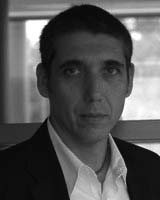
Congratulations to Adam Cowlard who successfully defended
his PhD thesis on the 28th of March 2009. The committee agreed to recommend awarding the Phd Degree without changes to his thesis.
The external examiner was Prof. Carlos Fernandez-Pello from the University of California at Berkeley and the internal was Dr Guillermo Rein.
The thesis title and abstract can be found bellow. Adam has led two journal papers directly related to his thesis in [
2009] and [
2007].

SENSOR and MODEL INTEGRATION for the RAPID PREDICTION of CONCURRENT FLOW FLAME SPREAD (full thesis available
in pdf )
by Adam Cowlard, University of Edinburgh, 2009
Supervisor:
Prof Jose Torero.
Sponsor:
BRE Trust and
FireGridAbstract:
Fire Safety Engineering is required at every stage in the life cycle of modern-day buildings. Fire safety design, detection and suppression, and emergency response are all vital components of Structural Fire Safety but are usually perceived as independent issues. Sensor deployment and exploitation is now common place in modern buildings for means such as temperature, air quality and security management. Despite the potential wealth of information these sensors could afford fire fighters, the design of sensor networks within buildings is entirely detached from procedures associated to emergency management. The experiences of
Dalmarnock Fire Test Two showed that streams of raw data emerging from sensors lead to a rapid information overload and do little to improve the understanding of the complex phenomenon and likely future events during a real fire. Despite current sensor technology in other fields being far more advanced than that of fire, there is no justification for more complex and expensive sensors in this context. In isolation therefore, sensors are not sufficient to aid emergency response.
Fire modelling follows a similar path. Two studies of Dalmarnock Fire Test One demonstrate clearly the current state of the art of fire modelling. A Priori studies by
Rein et al. 2009 showed that blind prediction of the evolution of a compartment fire is currently beyond the state of the art of fire modelling practice. A Posteriori studies by
Jahn et al. 2007 demonstrated that even with the provision of large quantities of sensor data, video footage, and prior knowledge of the fire; producing a CFD reconstruction was an incredibly difficult, laborious, intuitive and repetitive task.
Issues of accuracy aside, these models demand heavy resources and computational time periods that are far greater than the time associated with the processes being simulated. To be of use to emergency responders, the output would need to be produced faster than the event itself with lead time to enable planning of an intervention strategy. Therefore in isolation, model output is not robust or fast enough to be implemented in an emergency response scenario.
Fire fighting is therefore left as an isolated activity that does not benefit from sensor data or the potential of modelling the event. In isolation sensors and fire modelling are found lacking. Together though they appear to form the perfect compliment. Sensors provide a plethora of information which lacks interpretation. Models provide a method of interpretation but lack the necessary information to make this output robust. Thus a mechanism to achieve accurate, timely predictions by means of theoretical models steered by continuous calibration against sensor measurements is proposed.
The concept of super-real time predictions steered by measurements is studied in the simple yet meaningful scenario of concurrent flow flame spread. Experiments have been conducted with PMMA slabs to feed sensor data into a simple analytical model. Numerous sensing techniques have been adapted to feed a simple algebraic expression from the literature linking flame spread, flame characteristics and pyrolysis evolution in order to model upward flame spread. The measurements are continuously fed to the computations so that projections of the flame spread velocity and flame characteristics can be established at each instant in time, ahead of the real flame. It was observed that as the input parameters in the analytical models were optimised to the scenario, rapid convergence between the evolving experiment and the predictions was attained.
Open access to full thesis at http://hdl.handle.net/1842/2753































